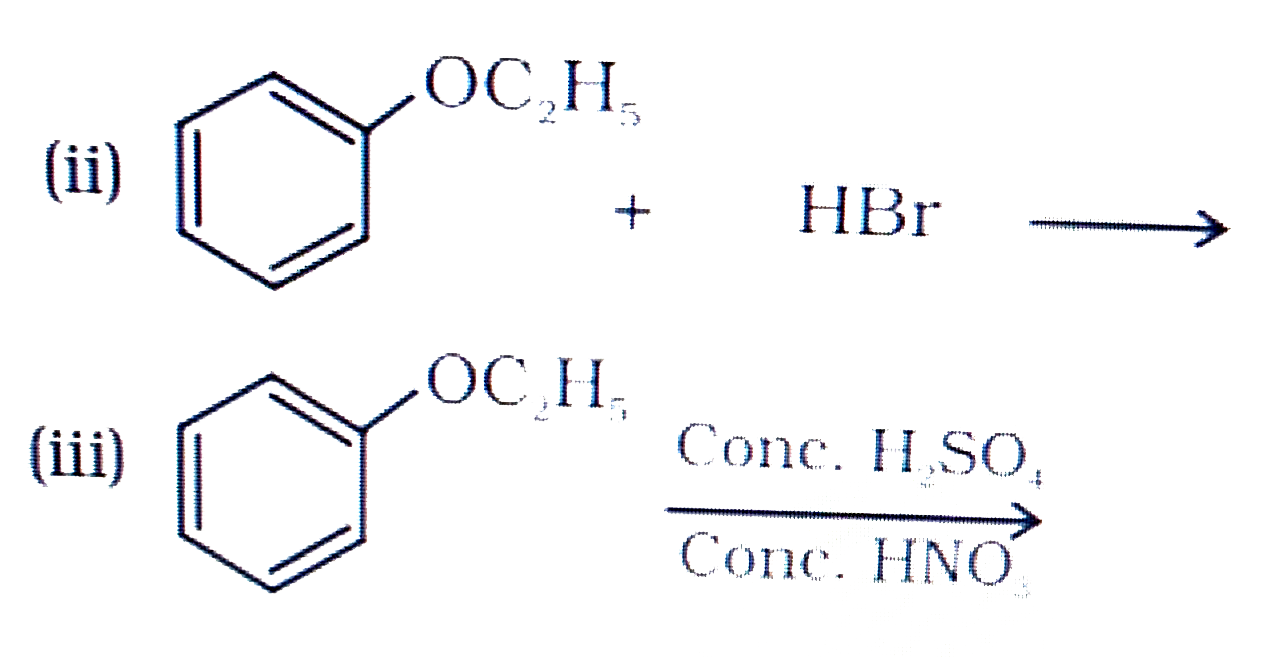The reaction, (CH3)3C−IH2O−−→(CH3)3C−OH is
elimination reaction
substitution reaction
free radical reaction
addition reaction.
The correct Answer is:B
To determine the type of reaction represented by the equation (CH₃)₃C−I+H₂O→(CH₃)₃C−OH, we can analyze the components and the process involved step by step.
1. Identify the Reactants and Products:
- The reactant is tert-butyl iodide, (CH₃)₃C−I, which contains three methyl groups attached to a central carbon atom and an iodine atom.
- The product is tert-butyl alcohol, (CH₃)₃C−OH, where the iodine atom has been replaced by a hydroxyl group (OH).
2. Analyze the Reaction Type:
- In this reaction, we observe that the iodine atom (I) is being replaced by a hydroxyl group (OH) from water (H₂O).
- This indicates that one functional group (iodine) is substituted by another functional group (hydroxyl).
3. Consider the Mechanism:
- The reaction involves the breaking of the carbon-iodine bond and the formation of a new carbon-oxygen bond.
- Since the iodine is replaced by the hydroxyl group, this process is characteristic of a substitution reaction.
4. Elimination of Other Options:
- Elimination Reaction: This would involve the removal of atoms or groups from the molecule, which is not happening here.
- Free Radical Reaction: There is no indication of free radicals being formed in this reaction, as it does not involve conditions like heat or light that would typically generate free radicals.
- Addition Reaction: This involves adding atoms or groups to a molecule without removing any, which does not apply here since we are replacing one group with another.
5. Conclusion:
- Based on the analysis, the reaction (CH₃)₃C−I+H₂O→(CH₃)₃C−OH is classified as a substitution reaction.
Final Answer:
The correct answer is B. Substitution reaction.
- The reactant is tert-butyl iodide, (CH₃)₃C−I, which contains three methyl groups attached to a central carbon atom and an iodine atom.
- The product is tert-butyl alcohol, (CH₃)₃C−OH, where the iodine atom has been replaced by a hydroxyl group (OH).
- In this reaction, we observe that the iodine atom (I) is being replaced by a hydroxyl group (OH) from water (H₂O).
- This indicates that one functional group (iodine) is substituted by another functional group (hydroxyl).
- The reaction involves the breaking of the carbon-iodine bond and the formation of a new carbon-oxygen bond.
- Since the iodine is replaced by the hydroxyl group, this process is characteristic of a substitution reaction.
- Elimination Reaction: This would involve the removal of atoms or groups from the molecule, which is not happening here.
- Free Radical Reaction: There is no indication of free radicals being formed in this reaction, as it does not involve conditions like heat or light that would typically generate free radicals.
- Addition Reaction: This involves adding atoms or groups to a molecule without removing any, which does not apply here since we are replacing one group with another.
- Based on the analysis, the reaction (CH₃)₃C−I+H₂O→(CH₃)₃C−OH is classified as a substitution reaction.
The correct answer is B. Substitution reaction.
Topper's Solved these Questions
- ORGANIC CHEMISTRY-SOME BASIC PRINCIPLES TECHNIQUESBOOK - PRADEEPCHAPTER - ORGANIC CHEMISTRY-SOME BASIC PRINCIPLES TECHNIQUESEXERCISE - Test Your Grip (I. Multiple Choice Questions)
1 Videos
- ORGANIC CHEMISTRY-SOME BASIC PRINCIPLES TECHNIQUESBOOK - PRADEEPCHAPTER - ORGANIC CHEMISTRY-SOME BASIC PRINCIPLES TECHNIQUESEXERCISE - Test Your Grip (II. Fill in the Blanks)
20 Videos
- ORGANIC CHEMISTRY-SOME BASIC PRINCIPLES TECHNIQUESBOOK - PRADEEPCHAPTER - ORGANIC CHEMISTRY-SOME BASIC PRINCIPLES TECHNIQUESEXERCISE - Problem For Practice
27 Videos
- HYDROGEN BOOK - PRADEEPCHAPTER - HYDROGEN EXERCISE - COMPETITION FOCUS (Assertion-Reason Type Questions) Type 2
15 Videos
- P-BLOCK ELEMENTS (NITROGEN FAMILY)BOOK - PRADEEPCHAPTER - P-BLOCK ELEMENTS (NITROGEN FAMILY)EXERCISE - Competition focus jee(main and advanced)/ medical entrance special) (VIII. Assertion-Reason Type Questions)
10 Videos
Similar Questions
Knowledge Check
The reaction, (CH3)3C−IH2O−−→(CH3)3C−OH is
Aelimination reactionBsubstitution reactionCfree radical reactionDaddition reaction.The reaction
(CH3)3CbrH2O−−→(CH3)3C−OH isAelimination reactionBsubstitution reactionCfree radical reactionDdisplacement reactionFollowing reaction:
(CH3)3C−Br+H2O→(CH3)3C−OH+HBr is an example of -AElimination reactionBFree radical substitutionCNucleophilic substitutionDElectrophilic substitution
Rank the transition states that occur during the following reaction steps in order of increasing stability (least → stable)
1. H3C−+OH2→CH+3+H2O
2. (CH3)3C−+OH2→(CH3)3C++H2O
3. (CH3)2CH−+OH2→(CH3)2CH++H2O
View SolutionAMg−−−−−−→(C2H5)2OBC2H5OH−−−−→(CH3)2CH−CH3
In the above sequence the starting compound A is
View Solution(CH3)3C=CHCOOHA−−→(CH3)2C=CHCH2OH
The reagent A in the reaction is
View SolutionThe correct order of equilibrium constants for the reactions is H2CO+H2OK1⇐⇒H2C(OH)2
CH3CH2CHO+H2OK2⇐⇒CH3CH2CH(OH)2
CH3COCH3+H2OK3⇐⇒CH3C(OH)2CH3
View SolutionThe reaction.
CH3−O∣∣C−OCH3+C2H5H+orOH−−−−−−−−−→
CH3−O∣∣C−OC2H5+CH3OHis called
View Solution

